Sabrina Chang (章瑞蓮) was devastated when her husband, Winston Cheng (鄭雯), died in 2010.
A successful businesswoman in Taiwan before her family immigrated to New Zealand in 1995, in addition to looking after her husband and two daughters, she became active in local community services in the North Island city of Hamilton and ended up being appointed a justice of the peace in 2005.
However, when her husband died, she shut herself away from the world.
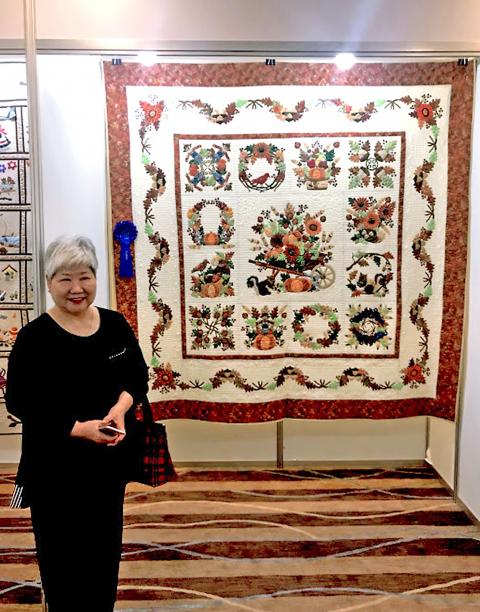
Photo courtesy of Sabrina Chang
“I felt so dead for two years, I didn’t do anything, didn’t see friends,” she told the Taipei Times over tea and coffee at the Grand Hotel on Friday last week.
Her two daughters, Daisy, an academic at Michigan State University, and Maggie, a chartered accountant with PwC, grew very concerned. Daisy urged Maggie to try and get their mother out of the house.
DRYING TEARS
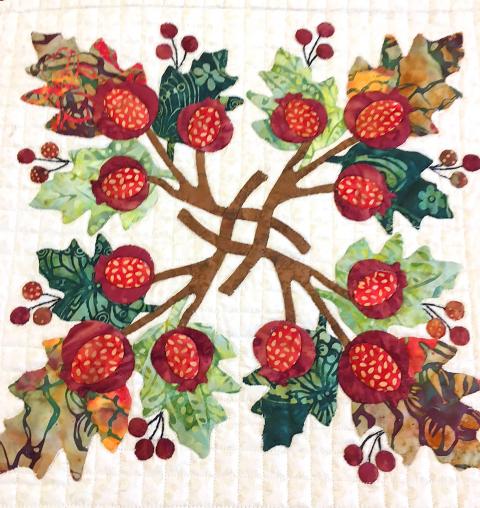
Photo courtesy of Sabrina Chang
Maggie suggested visiting Grandmother’s Garden, a patchwork and quilting shop in Hamilton, to see if there might be workshops or something of interest, since her mother had taken up patchwork sewing as a hobby a few years before.
The minute they walked into the store, Chang saw a huge quilt on a wall, a classic design known as a Baltimore Fall.
She fell in love with it, and the rest is history — albeit a history forged of years of frustration, tears, determination and patience. A lot of tears.
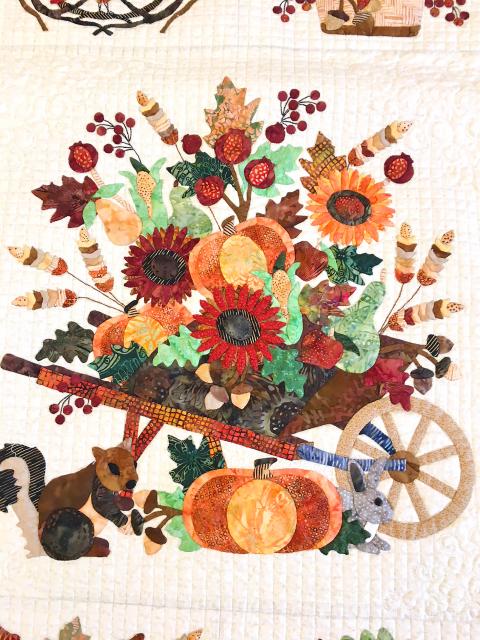
Photo courtesy of Sabrina Chang
However, in March this year, the 72-year-old who had never even held a needle and thread in her hands until she was 60, won first and second prize in the traditional category at the sixth International Quilt Show Dubai in the United Arab Emirates.
They were the first quilts she had ever made, in the first quilt show she had ever entered.
“Winning was [a] total surprise, total happiness,” she said.
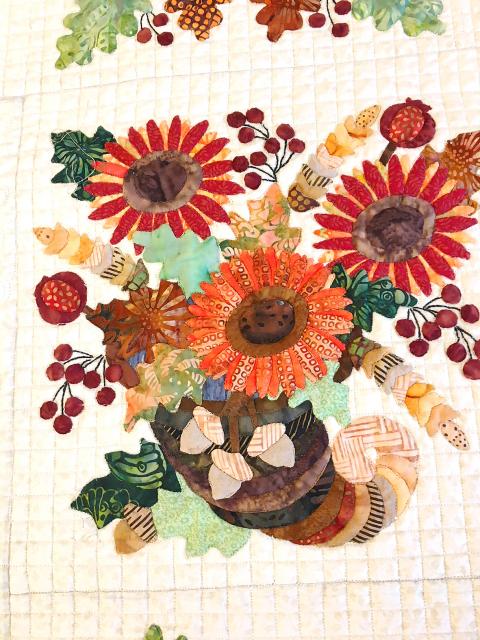
Photo courtesy of Sabrina Chang
I had heard about her win through mutual friends, but I had not met Chang before Friday. In an e-mail confirming our appointment, she told me to look for a gray-haired woman in a black dress. That unfussy directness appears to be one of her defining characteristics.
PERFECTIONIST
It turns out perfectionism is another, and the willingness to try new things.
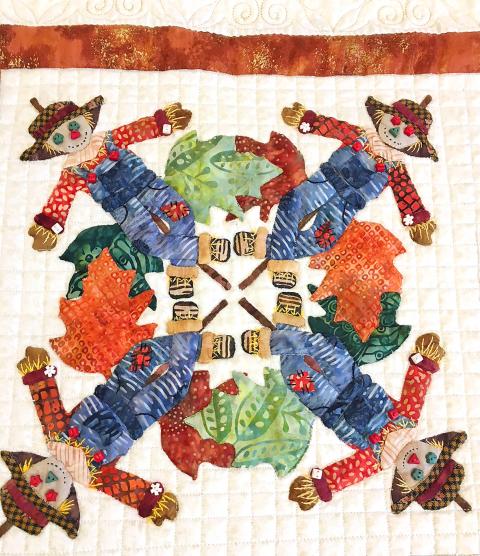
Photo courtesy of Sabrina Chang
She said her perfectionism irritated her younger sister, Olivia Jen (鄭瑞芳), who introduced her to needlework 12 years ago, as well as her subsequent teachers, such as the South Korean woman, Kim Re-nei, she first took needlework classes with in Hamilton.
Jen had suggested she start off with something simple, like a pencil case.
“I thought a pencil case would be good because I do a lot of volunteer work, use a lot of pens,” Chang said.
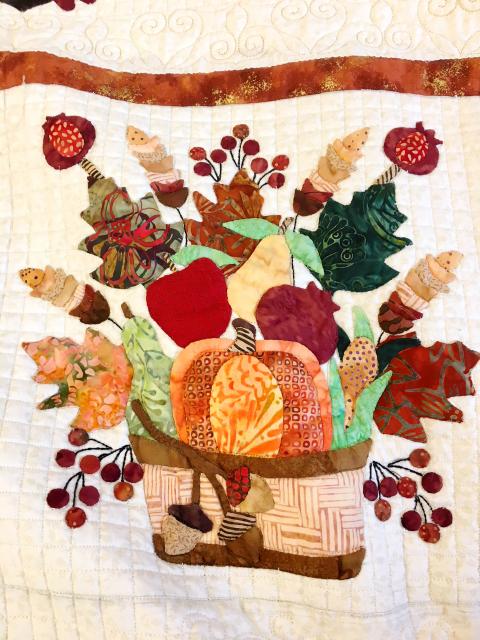
Photo courtesy of Sabrina Chang
However, after demonstrating how to stitch the fabric together, Jen left the table and Chang tore out all of the stitches and did them over. Her sister was furious.
“‘There is no perfection in handsewn,’ she said, but I just laughed,” Chang said.
“I don’t think I’m doing anything wrong, I just like doing it right” she said with a grin.
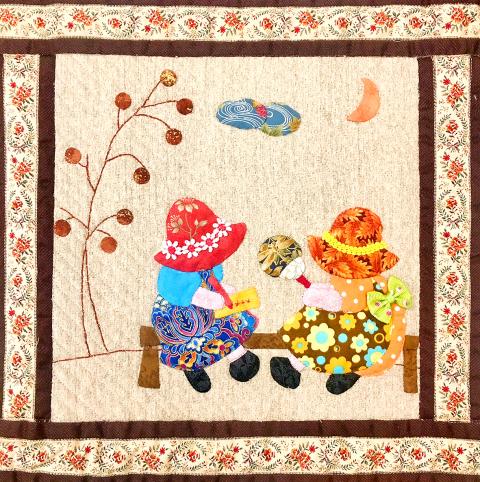
Photo courtesy of Sabrina Chang
Her sewing had mostly been on small handicraft projects, so when she saw the Baltimore Fall quilt, as much as she loved it, she thought it was out of her league.
The top panel of the quilt is all applique and patchwork, a complicated border design surrounding 12 small blocks and a centerpiece, all done in the old-fashioned technique called needle turn so the stitching does not show. Since Chang does not know how to use a sewing machine, it would have to be all handsewn.
Chang said she was willing to try doing one of the smaller blocks, but the store said it sold the patterns only as part of a complete set.

Photo courtesy of Sabrina Chang
She decided against it, but Maggie was undeterred and bought the entire set for her mother, as part of the store’s “Block of the Month” series.
Maggie told her: “All you need is patience, you can do it.”
There are a lot of leaves on a Baltimore Fall quilt, and when Chang started, it took her three hours just to sew one leaf onto the white background square. She was still working on the first block when the second one arrived, and then the third, which left her feeling overwhelmed.
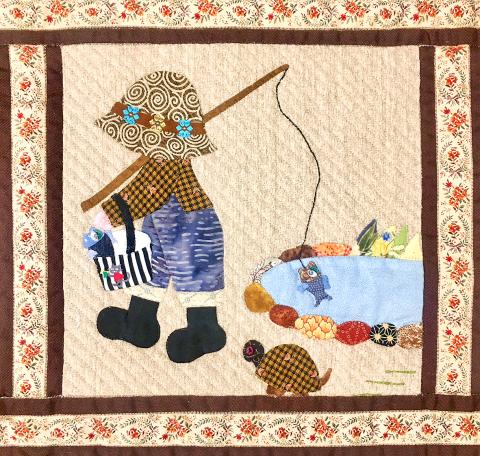
Photo courtesy of Sabrina Chang
Ready to quit, Chang was encouraged when Maggie took her back to the shop and one of the employees complimented her on what she had done so far. The woman suggested she take a quilting class with a tutor, Ngaire Brooks.
PERSEVERANCE
Chang persevered with a weekly Tuesday class with Brooks, even though she grew frustrated. She says she felt like her progress was too slow and she was behind the other students. She also found her teacher unhelpful.
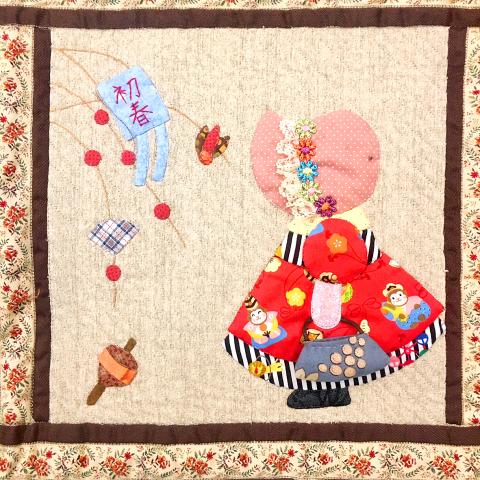
Photo courtesy of Sabrina Chang
Maggie suggested that she buy some small things from Brooks, to show that she was serious, and Chang took her advice, buying scissors and small pieces of fabric. One day when Chang was working on a block with four scarecrows, each with a pair of very tiny shoes, Brooks suggested it would be easier to use fabric glue rather than big pins to hold the shoes in place as she sewed them.
“That was the first breakthrough,” Chang said.
Brooks’ next tip was freezer paper, another way of holding pieces of fabric in place to be sewn.

Photo courtesy of Sabrina Chang
“I started to practice: on leaves, pomegranates, all kinds of flower designs. It took three months to do the first 24-inch [61cm] block, but after learning to use freezer paper, a block took just three weeks,” Chang said.
She then began to change the colors on the quilt, collecting pieces of fabric in her travels to the US and Australia.
“Color is so personal,” she said.
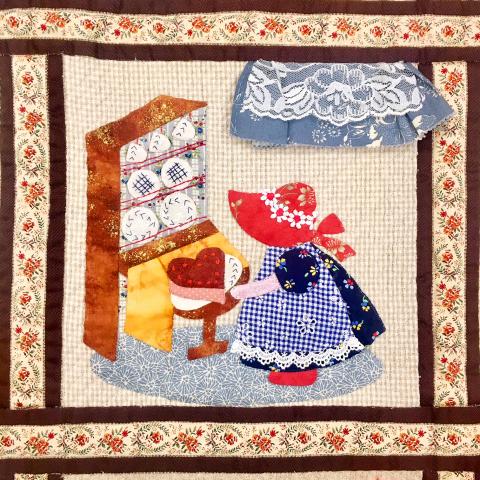
Photo courtesy of Sabrina Chang
She worked on the quilt for five to six hours a day; it took her three years and nine months to finish — with some time out to move back to Taipei in 2014 after Maggie took a posting in Dubai and her daughters felt that she should be closer to her sister and friends for health reasons (Chang had heart surgery, with six stents put in).
“I was so focused … I missed my husband so much I cried. I felt my daughters’ love, felt sadness, frustration, it was all sewn into the stitches. I forgot everything else and concentrated, I didn’t want to disappoint my daughters,” she said.
Quilting also reinforced her perfectionism. There are more than 268 berries on the quilt. They are supposed to be perfect circles, but as her sewing improved, Chang said she realized the early ones looked more like hexagons. So she ripped them off and did them again — perfectly.
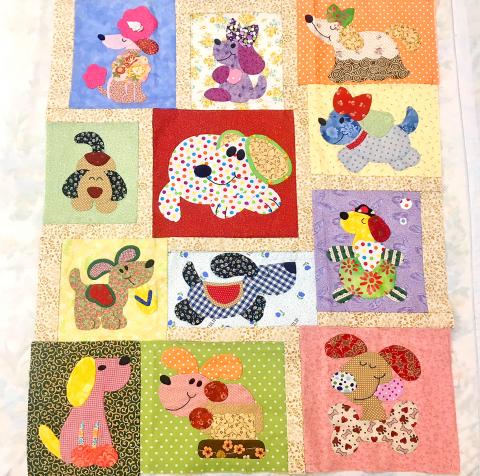
Photo courtesy of Sabrina Chang
FIRST PRIZE
In awarding Chang’s Baltimore Fall first prize, the judges praised its “excellent color combination, beautifully executed stitch work,” she said. They also told her they appreciated the emotion she put into it.
They gave her Sunbonnet Holiday quilt second prize. Unlike the Baltimore Fall, which she worked from a pattern, the second quilt was completely Chang’s own design, although it is based on a character from a 19th century children’s book, Sunbonnet Sue. She also added some Chinese motifs.
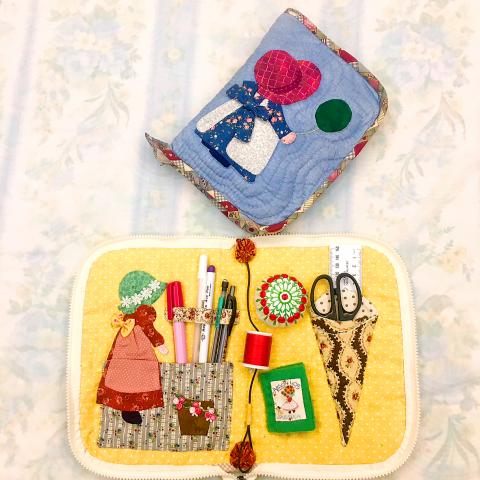
Photo courtesy of Sabrina Chang
Chang said her sister had told her that with two daughters, she needed to make a quilt for each of them. So she started Sunbonnet Holiday for Maggie.
The quilt has 36 characters, each engaged in a different activity. And although the fabric, ribbons and lace are also different for each character, they are united in their cheerful disposition.
“I was in a very happy situation making this quilt for my daughter,” she said.
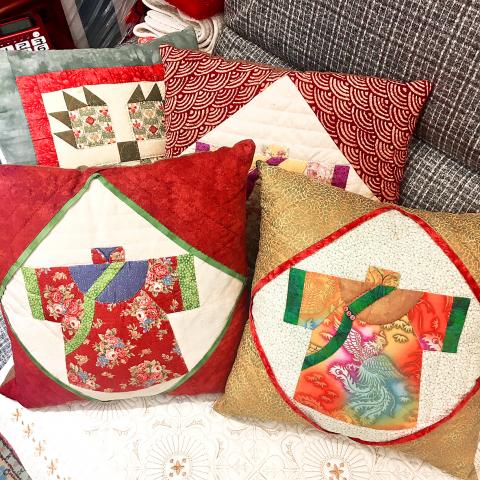
Photo courtesy of Sabrina Chang
The second time around it only took her one year and 11 months to finish.
Quilting is an expensive hobby she said, and addictive, since she finds herself going to fabric stores on her travels to add to her collection of more than 300 types of fabric in her workroom at home.
It was a visit to a fabric store in Dubai, on a trip to see her daughter, that led to Chang winning two prizes.
She noticed there was a long arm sewing machine in the shop, so Chang asked the Indian woman who owned the shop if she did lamination — the process of sewing differing layers together.
While Chang can do the applique and patchwork for the top layer of a quilt, sewing the top together with a layer of batting and a bottom sheet by hand would be too much.
“My hands are too small,” she said.
Not only did the Indian woman do the laminating on Sunbonnet Holiday, she told Chang about the Dubai show and suggested that she enter it.
Chang said she was over the moon to win not one, but two prizes, given that there were about 170 quilts of all sizes and techniques, and 10 categories for competition.
Her daughters and her sister are understandably proud of her accomplishments. It was Jen who suggesting having an exhibition in Taipei so Chang’s friends could see the quilts and some of her other work.
“She told me: ‘You were so old when you started, you could encourage other senior citizens,” Chang said.
She agreed because she feels you are never too old to learn something new — or to learn how to turn negative emotions into something constructive.
The Taipei Main Public Library came through with an offer for a week-long exhibition. However, Chang, who is still recovering from a bout of pneumonia, thought having to be at the library every day for week would be too much, so she decided to do just one day, this Friday.
At the exhibition will be the prizewinning quilts and some of the pillows, pictures and household objects she has made.
Yet perhaps the most fascinating of all will be Chang herself, proof, as she said, that totally unexpected things can happen in your life even when you are older.

Following the shock complete failure of all the recall votes against Chinese Nationalist Party (KMT) lawmakers on July 26, pan-blue supporters and the Chinese Communist Party (CCP) were giddy with victory. A notable exception was KMT Chairman Eric Chu (朱立倫), who knew better. At a press conference on July 29, he bowed deeply in gratitude to the voters and said the recalls were “not about which party won or lost, but were a great victory for the Taiwanese voters.” The entire recall process was a disaster for both the KMT and the Democratic Progressive Party (DPP). The only bright spot for

Water management is one of the most powerful forces shaping modern Taiwan’s landscapes and politics. Many of Taiwan’s township and county boundaries are defined by watersheds. The current course of the mighty Jhuoshuei River (濁水溪) was largely established by Japanese embankment building during the 1918-1923 period. Taoyuan is dotted with ponds constructed by settlers from China during the Qing period. Countless local civic actions have been driven by opposition to water projects. Last week something like 2,600mm of rain fell on southern Taiwan in seven days, peaking at over 2,800mm in Duona (多納) in Kaohsiung’s Maolin District (茂林), according to

Aug. 11 to Aug. 17 Those who never heard of architect Hsiu Tse-lan (修澤蘭) must have seen her work — on the reverse of the NT$100 bill is the Yangmingshan Zhongshan Hall (陽明山中山樓). Then-president Chiang Kai-shek (蔣介石) reportedly hand-picked her for the job and gave her just 13 months to complete it in time for the centennial of Republic of China founder Sun Yat-sen’s birth on Nov. 12, 1966. Another landmark project is Garden City (花園新城) in New Taipei City’s Sindian District (新店) — Taiwan’s first mountainside planned community, which Hsiu initiated in 1968. She was involved in every stage, from selecting

As last month dawned, the Democratic Progressive Party (DPP) was in a good position. The recall campaigns had strong momentum, polling showed many Chinese Nationalist Party (KMT) lawmakers at risk of recall and even the KMT was bracing for losing seats while facing a tsunami of voter fraud investigations. Polling pointed to some of the recalls being a lock for victory. Though in most districts the majority was against recalling their lawmaker, among voters “definitely” planning to vote, there were double-digit margins in favor of recall in at least five districts, with three districts near or above 20 percent in